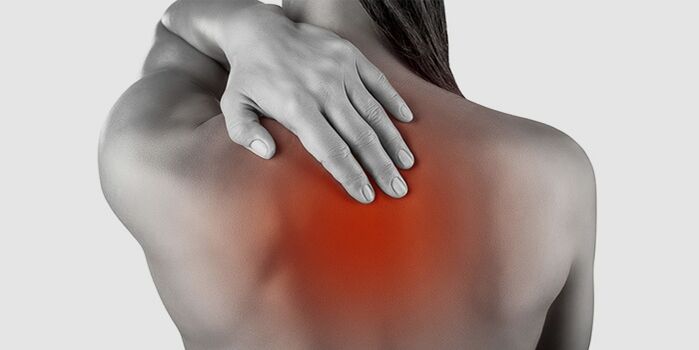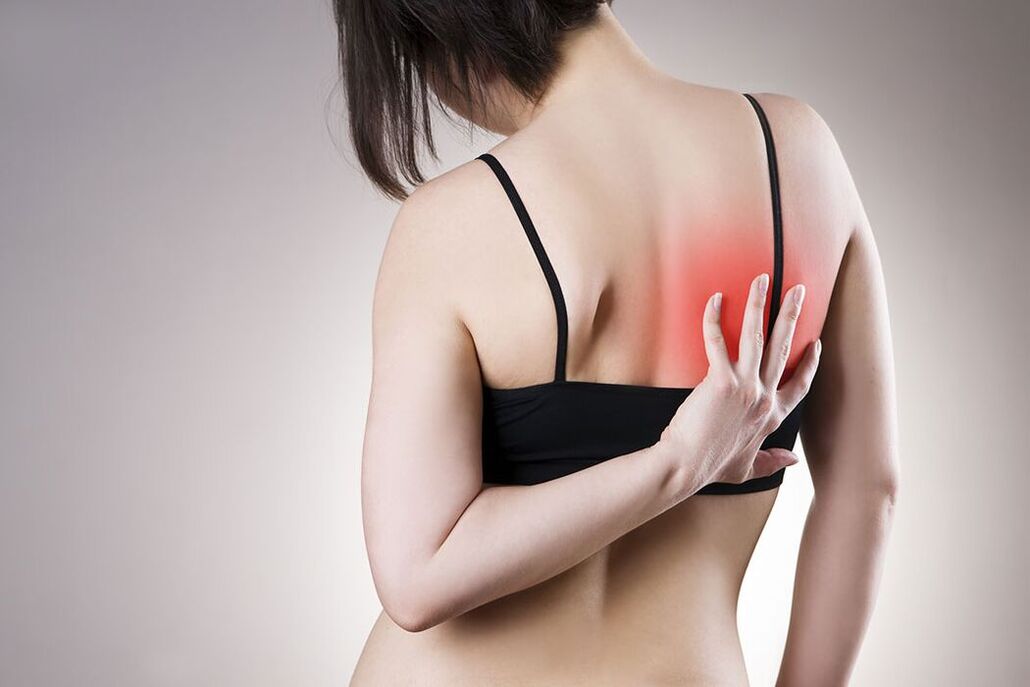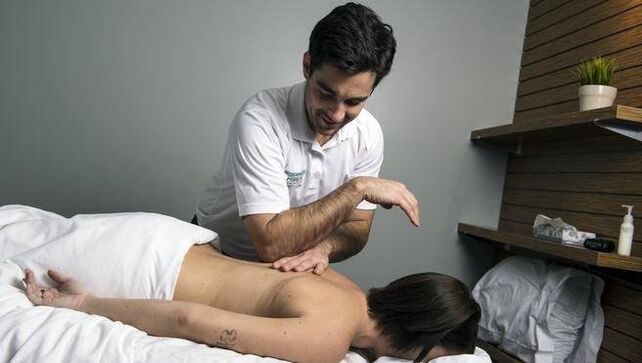Both older and younger people report back pain in the shoulder blade area. Pain in the interscapular region does not indicate any particular disease, but is a manifestation of numerous abnormalities in the work of organs located outside the pain concentration zone.

If the back hurts in the area of the shoulder blades, then the muscles, nerves, facet joints, ligaments, pathological changes in internal organs, the consequences of blows and injuries, etc. , may be a likely pretext for pain.
The nature of pain
In medical practice, the rational description that the patient makes of his pain in the lower back is of great importance. Pain between the shoulder blades is a symptom of a number of diseases or pathologies; It is possible to discover the cause of the appearance with a precise description of its nature, its type, the frequency of appearance and disappearance. A correct diagnosis will eliminate a burning sensation in the back, pain in the shoulder blades, the reasons will be determined, with the help of a doctor, and future diseases will be avoided.
By the nature of back pain syndrome it is:
- chronic - mild pain is typical, bothersome for a long time, practically does not stop;
- acute - specific pain, suddenly pounding and disappearing, much stronger than chronic.
When the back hurts in the area of the shoulder blades, the localization of painful sensations occurs in different places. This gives a reason to classify shoulder blade pain into three types:
- pain under the shoulder blades (right or left);
- pain between the shoulder blades;
- pain in the scapula to the right or to the left.
Back hurts below shoulder blades
The causes of pain may have absolutely nothing to do with the spine. If a person has back pain below the shoulder blades, by a series of accompanying signs, without examinations and analysis, it can be implied that they have the presence of typical common ailments.
Pathologies that cause pain under the left shoulder blade:
- Stomach ulcer. It is characterized by increasing and regular pain, which weakens or disappears after vomiting. Pain sensations in the epigastrium are localized, but penetrate the left scapula.
- Psychological problems. They provoke hardly noticeable or sharp sensations of heaviness, congestion in the chest, tingling in the region of the heart, compression in the chest. There are cases when such symptoms capture the neck area, spread under the left shoulder blade.
What caused the pain under the right shoulder blade?
The way in which a symptom manifests determines its causes.

The list of reasons for pain under the right shoulder blade is extensive. Examples of the most common:
- Dull, persistently disturbing and persistent pain in the right side of the back can be caused by the usual spasm in the muscles due to prolonged uncomfortable posture of the body, or associated with internal organs: kidneys, pancreas, gallbladder. In most cases, the pain appears unexpectedly, with a sharp turn of the head, sneezing, coughing.
- Sharp, stabbing, sharp, or increasing pain, localized to the right in the region of the heart or in the interscapular space, may be the result of disease of the internal organs and is not associated with the spine. Many body systems due to deviations from the norms of functioning cause pain under the right shoulder blade: cardiovascular, excretory, digestive, etc.
- A drawing and cutting pain under the right scapula suggests the appearance of diseases of the musculoskeletal system: chondrosis, osteochondrosis, spondylosis, etc. This type of pain can be caused by neuralgia when nerve roots are pinched. The reasons for such painful sensations can be oncological tumors, not often, but such phenomena are present in medical practice.
- The patient has pain in the back muscles under the shoulder blades, then you need to think about diseases of the respiratory system. Pain under the shoulder blades can be caused by muscle overload there or by the thoracic spine.
- Osteochondrosis of the cervical spine. It often causes dull, one-sided pains that are concentrated below the occipital part. Its peculiarity is to appear in the morning, bringing the patient out of sleep. The pain syndrome is especially strong with sharp flexion - extension of the neck. Exposure to heat on the painful surface (warm bath) extinguishes the pain. Patients react to this pathology with a complaint about pain under the shoulder blades, the flow of pain to the arm or head.
Causes of pain between the shoulder blades.
Intercostal neuralgia manifests as throbbing pain in the waist. With a deep breath, a sharp turn of the body, with palpation of the inflamed area between the ribs, the pain increases.

Diseases of the lungs are accompanied by pain between the shoulder blades when inhaling, with a deep breath, the pain intensifies, there is a high temperature, cough.
In the case of increased pain with shallow breathing, most often given under the right scapula, there may be a diaphragmatic abscess.
When the habitual tilt of the head causes pain between the shoulder blades, this is associated with an inflammatory process in the muscles of the interscapular region, as well as damage to its tendons and ligaments.
Pain between the shoulder blades sometimes occurs when swallowing, its origin is caused by diseases of the esophagus (inflammation or ulcer); inflammatory processes in the organs located between the two lungs; Damage to the diaphragm.
A burning sensation between the shoulder blades leads to bouts of kidney and biliary colic, osteochondrosis of the cervical or thoracic vertebrae, and reflux esophagitis.
Pain in the scapula to the right and left.
The reason is to receive a blow to the shoulder blade or fall on it. An uncomfortable fall on the arm or elbow will result in a fractured scapula. Trauma causes severe pain syndrome, the intensity of pain increases with movement of the hands. Edema forms.
Pterygoid scapula. It appears as a result of muscle paralysis: trapezoidal, rhomboid, anterior toothed or is the result of numerous bruises in the forearm region, damage to the long thoracic nerve.
Scapular crunch: crunch in the shoulder joint.
Treatment methods
At the beginning of treatment, you need to determine the state of the lungs and heart. Your cardiologist and therapist will most likely prescribe an EKG or ultrasound procedure. After consulting with specialists, you cannot safely consider that these organs are the causes of pain between the shoulder blades.
When pain occurs when the spine moves close to the scapula, the cause is usually found in the back. Sometimes the pain is so severe that it can be mistaken for symptoms of panic attacks.
The usual x-ray in the diagnosis of the spine is often not enough, the complete image is obtained by an MRI of the thoracic region. At this stage of clarifying the diagnosis, consultation with a vertebrologist is required.
It is possible to get rid of pain in the area of the right scapula by treatment only when the causes of its occurrence are clarified. When this pain is associated with diseases of the internal organs, it is necessary to treat them. Which doctor will treat depends on the specific organ. The pain under the right shoulder blade will go away on its own when the treatment of the affected internal organ is successful.
If there is a connection between pain in the right back and in the interdulobular region with diseases of the spine, medical attention will focus on the focus of inflammation. To eliminate the inflammatory process, painkillers, chondroprotectors, non-steroidal anti-inflammatory drugs, corticosteroids are used.
Dull pain that does not go away for a long time, as a result of muscle spasm or neuralgia, is effectively treated with hot ointments with analgesic effect. In addition, plasters are used, which provide a calming and analgesic effect.
Prophylaxis
The back in the area of the shoulder blades will not hurt if a person moves a lot and follows a healthy lifestyle. The movements provide uniform loads on the muscles, correct lifting of weights, massage sessions and various types of physical therapy. Sport is the best preventive measure.

Be careful with drafts, hypothermia. And, most importantly, observe proper nutrition.



































